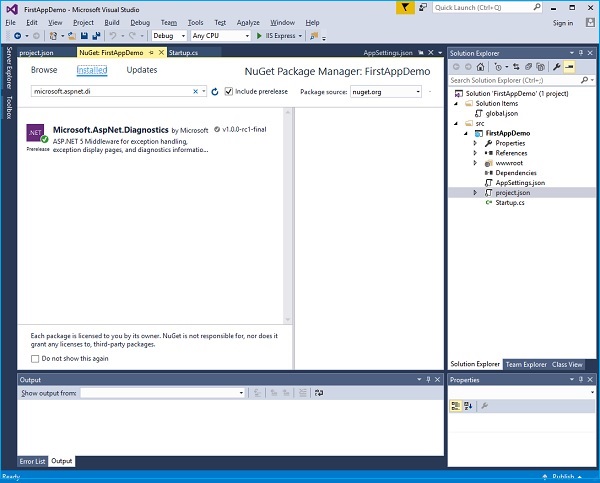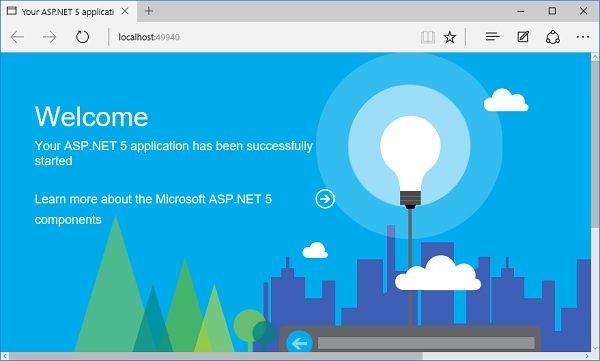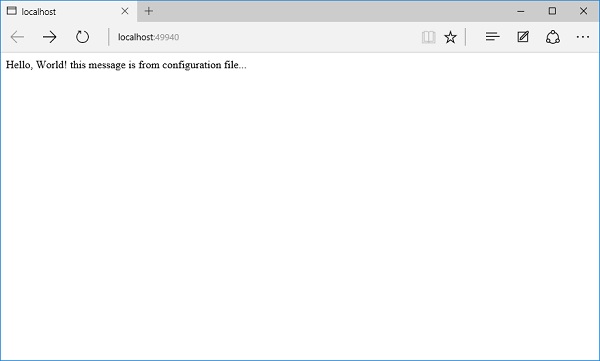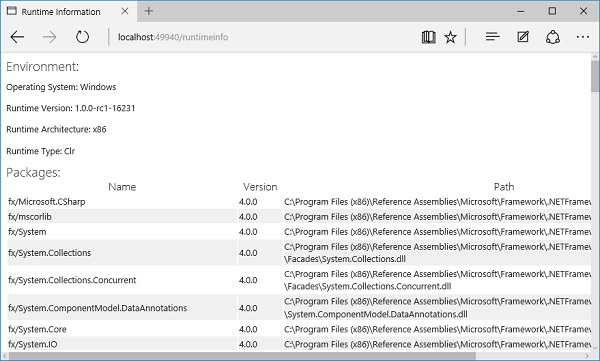ASP.NET Core中间件设置教程(7)
发布于 2017-09-06 07:18:50 | 208 次阅读 | 评论: 0 | 来源: 网友投递
.NET Core .NET 核心类库
.NET Core(corefx)是微软 .NET 框架的核心类库,这是 .NET Foundation 项目的一部分。
这篇文章主要为大家详细介绍了ASP.NET Core中间件的设置教程,具有一定的参考价值,感兴趣的小伙伴们可以参考一下
Asp.Net Core-中间件
在这一章,我们将了解如何设置中间件。中间件技术在 ASP.NET Core中控制我们的应用程序如何响应 HTTP 请求。它还可以控制应用程序的异常错误,这是一个在如何进行身份验证和授权用户执行特定的操作的关键。
- 中间件是组装成应用的管道来处理请求和响应的软件组件。
- 每个组件可以选择是否要在管道中将请求传递到下一个组件,并可以在管道中执行某些操作之前和之后的任务。
- Request委托用于构建请求管道。Request委托用来处理每个HTTP请求。
- 每件中间件在 ASP.NET Core都是一个对象,并且每一块有非常具体、 专注和有限的作用。
- 最终,我们需要很多的中间件为应用程序提供适当的行为。
现在让我们假设我们想将每个对我们应用程序的请求都记录日志。
- 在这种情况下,我们安装到应用程序中的第一块中间件是一个日志组件。
- 这个日志程序可以看到一切传入的请求,然后该中间件只是记录一些信息,然后传递这个请求下一个块中间件。

- 中间件是以一系列的组件出现在这个处理管道中。
- 我们安装到应用程序的下一个中间件是一个授权组件。
- 一个组件可能是寻找特定cookie或访问HTTP标头中的令牌。
- 如果授权组件发现一个令牌,它允许请求继续。
- 如果不是,授权组件本身可能会响应请求的HTTP错误代码或将用户重定向到登录页面。
- 否则,授权组件将请求传递给下一个路由器的中间件。
- 一个路由器查看URL,并确定下一步的行动。
- 路由器是在做一些回应,如果路由器没有找到任何回应,路由器本身可能会返回404 Not Found错误。
案例
现在让我们通过一个简单的例子来理解更多关于中间件的知识。我们通过使用我们的启动类的Configure方法来配置中间件组件。
using Microsoft.AspNet.Builder;
using Microsoft.AspNet.Hosting;
using Microsoft.AspNet.Http;
using Microsoft.Extensions.DependencyInjection;
using Microsoft.Extensions.Configuration;
namespace FirstAppDemo {
public class Startup {
public Startup() {
var builder = new ConfigurationBuilder()
.AddJsonFile("AppSettings.json");
Configuration = builder.Build();
}
public IConfiguration Configuration { get; set; }
// This method gets called by the runtime.
// Use this method to add services to the container.
// For more information on how to configure your application,
// visit http://go.microsoft.com/fwlink/?LinkID=398940
public void ConfigureServices(IServiceCollection services) {
}
// This method gets called by the runtime.
// Use this method to configure the HTTP request pipeline.
public void Configure(IApplicationBuilder app) {
app.UseIISPlatformHandler();
app.Run(async (context) => {
var msg = Configuration["message"];
await context.Response.WriteAsync(msg);
});
}
// Entry point for the application.
public static void Main(string[] args) => WebApplication.Run<Startup>(args);
}
}
Configure()方法内,我们将调用IApplicationBuilder接口的扩展方法来添加中间件。
默认情况下在一个新的空项目有两块中间件-
IISPlatformHandler
Middleware registered with app.Run
IISPlatformHandler
IISPlatformHandler允许我们使用Windows身份验证。它将着眼于每个传入请求,看看是否有任何Windows身份信息相关的请求,然后调用下一个块中间件。
Middleware registered with app.Run
在这种情况下一个中间件在app.Run中注册的中间件。Run方法允许我们传入另一种方法,我们可以使用它来处理每一个响应。Run方法不是你经常会看到的,我们可以称它为一个中间件的终端。
你注册运行的中间件将永远不会有机会调用另一个中间件,它唯一能做的就是接收请求,便要产生某种反应。
你也访问到一个响应对象,你可以在响应对象中添加一些字符串。
如果你想在app.Run之后注册另一个中间件,这段中间件将永远不会被调用,因为Run方法是一个中间件的终端。它不会调用下一个块中间件。
如何添加一个中间件
让我们着手进行以下步骤来添加另一个中间件 −
步骤1−右键单击项目并选择Manage NuGet Packages。
步骤2−搜索 Microsoft.aspnet.diagnostics,此特定的软件包包含许多不同种的中间件,我们可以使用。

步骤3−如果该包没有安装在您的项目中,那选择安装这个包。
步骤4−现在让我们在Configure()方法调用app.UseWelcomePage中间件。
// This method gets called by the runtime.
// Use this method to configure the HTTP request pipeline.
public void Configure(IApplicationBuilder app) {
app.UseIISPlatformHandler();
app.UseWelcomePage();
app.Run(async (context) => {
var msg = Configuration["message"];
await context.Response.WriteAsync(msg);
});
步骤 5 − 运行您的应用程序,您将看到以下的欢迎屏幕。

这个欢迎屏幕可能不是那么有用。
步骤6−让我们试试别的东西,可能是更有用的,而不是使用欢迎页面,我们将使用RuntimeInfoPage。
// This method gets called by the runtime.
// Use this method to configure the HTTP request pipeline.
public void Configure(IApplicationBuilder app) {
app.UseIISPlatformHandler();
app.UseRuntimeInfoPage();
app.Run(async (context) => {
var msg = Configuration["message"];
await context.Response.WriteAsync(msg);
});
}第 7 步 − 保存您的 Startup.cs 页面并刷新您的浏览器,你会看到下面的页面。

这个 RuntimeInfoPage 是中间件,将只响应一个特定的 URL 的请求。如果传入的请求与该 URL 不匹配,这个中间件只是让请求传递到下一件中间件。该请求将通过 IISPlatformHandler 中间件,然后转到 UseRuntimeInfoPage 中间件。它不会创建响应,所以它会转到我们的应用程序。运行并显示该字符串。
步骤8−我们在URL结尾添加“ runtimeinfo”。现在,您将看到一个页面,该页面是由中间件运行时信息页面。

你将看到一个返回页面,它给你展示了一些关于你的运行时环境,如操作系统、运行时版本,结构,类型和您正在使用的所有包的信息。
以上就是本文的全部内容,希望对大家的学习有所帮助,也希望大家多多支持PHPERZ。